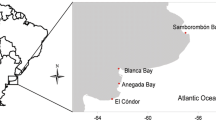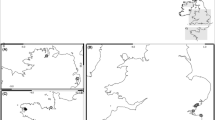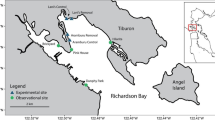Abstract
Documenting establishment and spread of invasive species requires extensive co-ordinated sampling programmes. Identifying the factors promoting or inhibiting local establishment of an invasive species can improve capacity to predict further spread and underpin strategies to limit spread. Here, a structured sampling programme was used to assess the current distribution of feral populations of Pacific oysters, Crassostrea gigas, in Ireland. Sixty-nine sites were sampled using a standardised protocol combining semi-quantitative and quantitative approaches. Sites were chosen to represent variation in proximity to aquaculture and a range of environmental variables. Oyster populations were found at 18 locations, with densities ranging from single individuals to nine individuals per m2. The broad size range of oysters found is indicative of more than one recruitment event. Logistic regression indicated that feral oysters were positively associated with the presence of hard substrata or biogenic reef, long residence times of embayments and large intertidal areas. There was also a tendency for oysters to occur disproportionately in bays with aquaculture, but >500 m from it. Small-scale analysis within sites showed that oysters were almost exclusively attached to hard substrata and mussel shell. The approach taken here provides a rigorous repeatable methodology for future monitoring and a detailed basis for the prediction of further spread.



Similar content being viewed by others
References
Akaike H (1974) A new look at the statistical model identification. IEEE T Autom Control 19:716–723
Anderson RP, Lew D, Peterson AT (2003) Evaluating predictive models of species’ distributions: criteria for selecting optimal models. Ecol Model 162:211–232
Andrew N, Viejo R (1998) Effects of wave exposure and intraspecific density on the growth and survivorship of Sargassum muticum (Sargassaceae: Phaeophyta). Eur J Phycol 33:251–258
Beger M, Possingham HP (2008) Environmental factors that influence the distribution of coral reef fishes: modeling occurrence data for broad-scale conservation and management. Mar Ecol Prog Ser 361:1–13
Branch GM, Odendaal F, Robinson TB (2008) Long-term monitoring of the arrival, expansion and effects of the alien mussel Mytilus galloprovincialis relative to wave action. Mar Ecol Prog Ser 370:171–183
Brandt G, Wehrman A, Wirtz KW (2008) Rapid invasion of Crassostrea gigas into the German Wadden Sea dominated by larval supply. J Sea Res 59:279–296
Brock E, Nylund GM, Pavia H (2007) Chemical inhibition of barnacle larval settlement by the brown alga Fucus vesiculosus. Mar Ecol Prog Ser 337:165–174
Browne R, Deegan B, O’Carroll T, Norman M, Ó’Cinnéide M (2007) Status of Irish aquaculture 2006. Marine Institute, Bord Iascaigh Mhara
Burrows MT, Harvey R, Robb L (2008) Wave exposure indices from digital coastlines and the prediction of rocky shore community structure. Mar Ecol Prog Ser 353:1–12
Byers JE, Pringle JM (2006) Going against the flow: retention, range limits and invasions in advective environments. Mar Ecol Prog Ser 313:27–41
Cadée GC (2004) Japanse oesters Crassostrea gigas gestikt onder algenbedekking in 2003. Het Zeepaard 64:110–114
Campbell ML, Gould B, Hewitt CL (2007) Survey evaluations to assess marine bioinvasions. Mar Pollut Bull 55:360–378
Carlton JT (1996) Marine bioinvasions: the alteration of marine ecosystems by nonindigenous species. Oceanography 9:36–43
Carrasco MF, Barón PJ (2010) Analysis of the potential geographic range of the Pacific oyster Crassostrea gigas (Thunberg, 1793) based on surface seawater temperature satellite data and climate charts: the coast of South America as a study case. Biol Invasions 12:2597–2607
Cognie B, Haure J, Barillé L (2006) Spatial distribution in a temperate coastal ecosystem of the wild stock of the farmed oyster Crassostrea gigas (Thunberg). Aquaculture 259:249–259
Connor DW, Allen JH, Golding N, Howell KL, Lieberknecht LM, Northen KO, Reker JB (2004) The marine habitat classification for Britain and Ireland (Version 04/05). JNCC, 49 pp
Cook EJ, Ashton G, Campbell M, Coutts A, Gollasch S, Hewitt C, Liu H, Minchin D, Ruiz G, Shucksmith R (2008) Non-native aquaculture species releases: implications for aquatic ecosystems. In: Holmer M, Black K, Duarte CM, Marbà N, Karakassis I (eds) Aquaculture in the ecosystem. Springer, Netherlands, pp 155–184
Couzens G (2006) The distribution and abundance of the non-native Pacific oyster, Crassostrea gigas, in West Devon—a result of climate change? In: Laing I (ed) Shellfish News, 22:5–7
Davies A, Johnson M (2006) Coastline configuration disrupts the effects of large-scale climatic forcing, leading to divergent trends in wave exposure. Estuar Coast Shelf Sci 69:643–648
De Knegt HJ, van Langevelde F, Coughenour MB, Skidmore AK, de Boer WF, Heitkönig IMA, Knox NM, Slotow R, van der Waal C, Prins HHT (2009) Spatial autocorrelation and the scaling of species–environment relationships. Ecology 91:2455–2465
Diederich S (2005) Differential recruitment of introduced Pacific oysters and native mussels at the North Sea coast: coexistence possible? J Sea Res 53:269–281
Diederich S (2006) High survival and growth rates of introduced Pacific oysters may cause restrictions on habitat use by native mussels in the Wadden Sea. J Exp Mar Biol Ecol 328:211–227
Diederich S, Nehls G, van Beusekom JEE, Reise K (2005) Introduced Pacific oysters (Crassostrea gigas) in the northern Wadden Sea: invasion accelerated by warm summers? Helgol Mar Res 59:97–106
Dormann CF, Elith J, Bacher S, Buchmann C, Carl G, Carré G, Marquéz JRG, Gruber B, Lafourcade B, Leitão PJ, Münkemüller T, McClean C, Osborne PE, Reineking B, Schröder B, Skidmore AK, Zurell D, Lautenbach S (2012) Collinearity: a review of methods to deal with it and a simulation study evaluating their performance. Ecography 35:1–20
Duarte C, Holmer M, Olsen Y, Soto D, Marbà N, Guiu J, Black K, Karakassis I (2009) Will the oceans help feed humanity? Bioscience 59:967–976
Dunstan PK, Bax NJ (2007) How far can marine species go? Influence of population biology and larval movement on future range limits. Mar Ecol Prog Ser 344:15–28
Dutertre M, Beninger PG, Barillé L, Papin M, Haure J (2010) Rising water temperatures, reproduction and recruitment of an invasive oyster, Crassostrea gigas, on the French Atlantic coast. Mar Environ Res 69:1–9
Dyer KR, Orth RJ (1994) Changes in fluxes in estuaries: implications from science to management. Olsen & Olsen, Fredensborg
Elith J, Leathwick JR (2009) Species distribution models: ecological explanation and prediction across space and time. Annu Rev Ecol Evol Syst 40:677–697
Elith J, Graham H, Anderson CP, Dudík R, Ferrier M, Guisan S, Hijmans AJ, Huettmann R, Leathwick J, Lehmann A et al (2006) Novel methods improve prediction of species’ distributions from occurrence data. Ecography 29:129–151
Escapa M, Isacch JP, Daleo P, Alberti J, Iribarne O, Borges M, Dos Santos E, Gagliardini DA, Lasta M (2004) The distribution and ecological effects of the introduced Pacific oyster Crassostrea gigas (Thunberg, 1793) in Northern Patagonia. J Shellfish Res 23:765–772
Eschweiler N, Christensen HT (2011) Trade-off between increased survival and reduced growth for blue mussels living on Pacific oyster reefs. J Exp Mar Biol Ecol 403:90–95
FAO Fisheries and Aquaculture Department (2012) The state of world fisheries and aquaculture 2012. Fisheries and Aquaculture Department. Food and Agriculture Organization of the United Nations, Rome
Fey F, Dankers N, Steenbergen J, Goudswaard K (2010) Development and distribution of the non-indigenous Pacific oyster (Crassostrea gigas) in the Dutch Wadden Sea. Aquac Int 18:45–59
Fielding AH, Bell JF (1997) A review of methods for the assessment of prediction errors in conservation presence/absence models. Environ Conserv 24:38–49
FAO Fisheries and Aquaculture Department (2012b) Fisheries and aquaculture fact sheets. http://www.fao.org/fishery/culturedspecies/Crassostrea_gigas/en, Accessed 2012 April, 21
Franklin J (2009) Mapping species distributions: spatial inference and prediction. Cambridge University Press, Cambridge
Gaines SD, Bertness MD (1992) Dispersal of juveniles and variable recruitment in sessile marine species. Nature 360:579–580
Garza-Pérez JR, Lehmann A, Arias-González JE (2004) Spatial prediction of coral reef habitats: integrating ecology with spatial modeling and remote sensing. Mar Ecol Prog Ser 269:141–152
Gillooly JF, Charnov EL, West GB, Savage VM, Brown JH (2002) Effects of size and temperature on developmental time. Nature 417:70–73
Gormley AM, Forsyth DM, Griffioen P, Lindeman M, Ramsey DS, Scroggie MP, Woodford L (2011) Using presence-only and presence–absence data to estimate the current and potential distributions of established invasive species. J Appl Ecol 48:25–34
Green DS, Boots B, Crowe TP (2012) Effects of non-indigenous oysters on microbial diversity and ecosystem functioning. PLoS ONE 7:e48410
Guy C, Roberts D (2010) Can the spread of non-native oysters (Crassostrea gigas) at the early stages of population expansion be managed? Mar Pollut Bull 60:1059–1064
Hartnett M, Dabrowski T, Olbert A (2011) A new formula to calculate residence times of tidal waterbodies. Proc ICE Water Manag 164:243–256
Hay CH, Luckens PA (1987) The Asian kelp Undaria pinnatifida (Phaeophyta: Laminariales) found in a New Zealand harbour. N Z J Bot 25:329–332
Helmuth B, Harley CDG, Halpin PM, O’Donnell M, Hofmann GE, Blanchette CA (2002) Climate change and latitudinal patterns of intertidal thermal stress. Science 298:1015–1017
Herborg LM, Rudnick DA, Siliang Y, Lodge DM, MacIsaac HJ (2007) Predicting the range of Chinese mitten crabs in Europe. Conserv Biol 21:1316–1323
Hulme PE, Weser C (2011) Mixed messages from multiple information sources on invasive species: a case of too much of a good thing? Divers Distrib 17:1152–1160
Hunt HL, Scheibling RE (1997) Role of early post-settlement mortality in recruitment of benthic marine invertebrates. Mar Ecol Prog Ser 155:269–301
Institute Marine (2012) Shellfish stocks and fisheries review 2011: an assessment of selected stocks. Marine Institute, Rinville, p 64. ISBN 978-1-902895-52-9
Jenkins SR, Norton TA, Hawkins SJ (1999) Settlement post-settlement interactions between Semibalanus balanoides (L) (Crustacea: Cirripedia) and three species of fucoid canopy algae. J Exp Mar Biol Ecol 236:49–67
Jenkins SR, Marshall D, Fraschetti S (2009) Settlement and recruitment. In: Wahl M (ed) Marine hard bottom communities, ecological studies 206. Springer, Berlin, pp 177–190
Johnston EL, Piola RF, Clark GF (2009) The role of propagule pressure in invasion success. In: Rilov G, Crooks JA, Caldwell MM, Heldmaier G, Jackson RB, Lange OL, Mooney HA, Schulze E-D, Sommer U (eds) Biological invasions in marine ecosystems. Springer, Berlin, pp 133–151
Kelly NM, Fonseca M, Whitfield P (2001) Predictive mapping for management and conservation of seagrass beds in North Carolina. Aquat Conserv 11:437–451
Kinlan BP, Gaines SD (2003) Propagule dispersal in marine and terrestrial environments: a community perspective. Ecology 84:2007–2020
Knights AM, Crowe TP, Burnell G (2006) Mechanisms of larval transport: vertical distribution of bivalve larvae varies with tidal conditions. Mar Ecol Prog Ser 326:167–174
Kochmann J, Carlsson J, Crowe TP, Mariani S (2012) Genetic evidence for the uncoupling of local aquaculture activities and a population of an invasive species—a case study of Pacific oysters (Crassostrea gigas). J Hered 103:661–671
Lockwood JL, Cassey P, Blackburn T (2005) The role of propagule pressure in explaining species invasions. Trends Ecol Evol 20:223–228
Mann R, Powell EN (2007) Why oyster restoration goals in the Chesapeake Bay are not and probably cannot be achieved. J Shellfish Res 26:905–917
McGonigle C, Cavanagh M, Santiago R (2011) Native oyster stock assessment Lough Foyle. The Loughs Agency (Foyle, Carlingford and Irish Lights Commission), Londonderry, Carlingford, Report Reference LA/0Y0211
Melo CMR, Silva FC, Gomes CHAM, Solé-Cava AM, Lazoski C (2010) Crassostrea gigas in natural oyster banks in southern Brazil. Biol Invasion 12:441–449
Minchinton TE, Scheibling RE (1993) Variations in sampling procedure and frequency affect estimates of recruitment of barnacles. Mar Ecol Prog Ser 99:83–88
Naylor RL, Williams SL, Strong DR (2001) Aquaculture—a gateway for exotic species. Science 294:1655–1656
Nehls G, Diederich S, Thieltges D, Strasser M (2006) Wadden Sea mussel beds invaded by oysters and slipper limpets: competition or climate control? Helgol Mar Res 60:135–143
O’Connor MI, Bruno JF, Gaines SD, Halpern BS, Lester SE, Kinlan BP, Weiss JM (2007) Temperature control of larval dispersal and the implications for marine ecology, evolution, and conservation. Proc Natl Acad Sci USA 104:1266–1271
Orensanz JM, Schwindt E, Pastorino G, Bortolus A, Casas G, Darrigran G, Elias R, Lopez Gappa JJ, Obenat S, Pascual M et al (2002) No longer the pristine confines of the world ocean: a survey of exotic marine species in the southwestern Atlantic. Biol Invasion 4:115–143
Pechenik J (1999) On the advantages and disadvantages of larval stages in benthic marine invertebrate life cycles. Mar Ecol Prog Ser 177:269–297
Pineda J, Hare J, Sponaugle S (2007) Larval transport and dispersal in the coastal ocean and consequences for population connectivity. Oceanography 20:22–39
Quayle DB (1988) Pacific oyster culture in British Columbia. Can Bull Fish Aquat Sci 218:241
Reise K (1998) Pacific oysters invade mussel beds in the European Wadden Sea. Mar Biodivers 28:167–175
Rigal F, Viard F, Ayata SD, Comtet T (2010) Does larval supply explain the low proliferation of the invasive gastropod Crepidula fornicata in a tidal estuary? Biol Invasion 12:3171–3186
Robinson LM, Elith J, Hobday AJ, Pearson RG, Kendall BE, Possingham HP, Richardson AJ (2011) Pushing the limits in marine species distribution modelling: lessons from the land present challenges and opportunities. Global Ecol Biogeogr 20:789–802
Roughgarden J, Gaines S, Possingham H (1988) Recruitment dynamics in complex life cycles. Science 241:1460–1466
Ruesink JL (2007) Biotic resistance and facilitation of a non-native oyster on rocky shores. Mar Ecol Prog Ser 331:1–9
Ruesink JL, Lenihan HS, Trimble AC, Heiman KW, Micheli F, Byers JE, Kay MC (2005) Introduction of non-native oysters: ecosystem effects and restoration implications. Ann Rev Ecol Evol Syst 36:643–689
Ruiz GM, Fofonoff PW, Carlton JT, Wonham MJ, Hines AH (2000) Invasion of coastal marine communities in North America: apparent patterns, processes, and biases. Annu Rev Ecol Syst 31:481–531
Schmidt A, Wehrmann A, Dittmann S (2008) Population dynamics of the invasive Pacific oyster Crassostrea gigas during the early stages of an outbreak in the Wadden Sea (Germany). Helgol Mar Res 62:367–376
Simberloff D, Rejmánek M (2011) Encyclopedia of biological invasions. University of California Press, Berkeley
Simberloff D, Martin J-L, Genovesi P, Maris V, Wardle DA, Aronson J, Courchamp F, Galil B, García-Berthou E, Pascal M, Pyšek P, Sousa R, Tabacchi E, Vilà M (2013) Impacts of biological invasions: what’s what and the way forward. Trends Ecol Evol 28:58–66
R Development Core Team (2011) R: A language and environment for statistical computing. R foundation for statistical computing, Vienna, Austria, ISBN 3-900051-07-0, http://www.R-project.org
Therriault TW, Herborg LM (2008) Predicting the potential distribution of the vase tunicate Ciona intestinalis in Canadian waters: informing a risk assessment. ICES J Mar Sci 65:788–794
Thieltges DW, Strasser M, Reise K (2003) The American slipper limpet Crepidula fornicata (L.) in the northern Wadden Sea 70 years after its introduction. Helgol Mar Res 57:27–33
Thomsen MS, McGlathery K (2006) Effects of accumulations of sediments and drift algae on recruitment of sessile organisms associated with oyster reefs. J Exp Mar Biol Ecol 328:22–34
Travis JMJ, Dytham C (1999) Habitat persistence, habitat availability and the evolution of dispersal. Proc Biol Sci 266:723–728
Troost K (2010) Causes and effects of a highly successful marine invasion: case-study of the introduced Pacific oyster Crassostrea gigas in continental NW European estuaries. J Sea Res 64:145–165
Vittinghoff E, Glidden DV, Shiboski SC, McCulloch CE (2005) Regression methods in biostatistics: linear, logistic, survival, and repeated measures models. Springer, New York
Wehrmann A, Herlyn M, Bungenstock F, Hertweck G, Millat G (2000) The distribution gap is closed—First record of naturally settled Pacific oysters Crassostrea gigas in the East Frisian Wadden Sea, North Sea. Senckenb Marit 30:153–160
Witte S, Buschbaum C, van Beusekom J, Reise K (2010) Does climatic warming explain why an introduced barnacle takes over after a lag of more than 50 years? Biol Invasion 12:3579–3589
Wrange AL, Valero J, Harkestad LS, Strand Ø, Lindegarth S, Christensen HT, Dolmer P, Kristensen PS, Mortensen S (2010) Massive settlements of the Pacific oyster, Crassostrea gigas, in Scandinavia. Biol Invasion 12:1145–1152
Zaniewski AE, Lehmann A, Overton J (2002) Predicting species spatial distributions using presence-only data: a case study of native New Zealand ferns. Ecol Model 157:261–280
Acknowledgments
We are grateful to everyone who helped in the field, and to Grainne O’Brien and the regional officers of BIM (Irish Sea Fisheries Board) for access to their aquaculture databases and for putting us into contact with aquaculture operators. We would also like to thank Ciarán McGonigle from the Loughs Agency and members of staff for their extensive help in Northern Ireland and Donegal. Many thanks are due to Mike Burrows who calculated wave fetch and Tomasz Dabrowski, Marine Institute, who calculated residence times. Claire Guy and Dai Roberts from Queen’s University Belfast and Heike Büttger from BioConsult in Husum, Germany, helped during the initial planning of the survey. Eoin O’Gorman helped with the histograms. This work was supported by the Graduate Research Education Programme in Sustainable Development at University College Dublin, which was funded by the Irish Research Council for the Humanities and Social Sciences (IRCHSS) and the Irish Research Council for Science, Engineering and Technology (IRCSET). The work was also done in association with the SIMBIOSYS (2007-B-CD-1-S1) project as part of the Science, Technology, Research and Innovation for the Environment (STRIVE) Programme, financed by the Irish Government under the National Development Plan 2007–2013, administered on behalf of the Department of the Environment, Heritage and Local Government by the Irish Environmental Protection Agency (EPA). We also thank two reviewers and the editor, Jennifer Ruesink, whose suggestions improved this paper substantially.
Author information
Authors and Affiliations
Corresponding author
Electronic supplementary material
Below is the link to the electronic supplementary material
10530_2013_452_MOESM1_ESM.xlsx
Table with raw data. Information in columns from left to right with column 1: number of site, 2: number of habitat, 3: name of bay (abbreviated), 4: coordinate of longitude, 5: coordinate of latitude, 6: wave fetch (log10 km), 7: SACFOR categories for oyster abundances (C = Common, F = Frequent, O = Occasional, R = Rare, N = Absent), 8: residence time of bay, 9: width of intertidal shore (1 = 0–50 m, 2 = 51–100 m, 3 = 101–150 m, 4 ≥ 151 m), 10: aquaculture (0 = absent, 1 = close, 2 = far), 11, 12, 13: % cover of substrata (XLSX 63 kb)
Rights and permissions
About this article
Cite this article
Kochmann, J., O’Beirn, F., Yearsley, J. et al. Environmental factors associated with invasion: modelling occurrence data from a coordinated sampling programme for Pacific oysters. Biol Invasions 15, 2265–2279 (2013). https://doi.org/10.1007/s10530-013-0452-9
Received:
Accepted:
Published:
Issue Date:
DOI: https://doi.org/10.1007/s10530-013-0452-9




